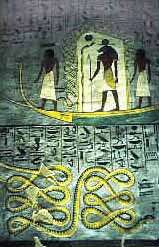Within the coffin text, the composition that today we refer to as the Book of the Two Ways is the most comprehensive. Usually placed on the inside bottom of coffins examined at Deir el-Bersha, various Egyptologists have divided it into four, or nine sections which can consist of a long version (spells 1,029 through 1,130) or a short version consisting of spells 1,131 through 1,185 but which also includes spells 513 and 577.
While the coffin text were available as a tool for the afterlife to all Egyptians, the spells were primarily employed by the local governors and their families of Middle Egypt. The content of the coffin text spells basically continued the tradition of the Pyramid Text, though the afterlife is better defined, and its dangers are portrayed more dramatically. They were intended to aid the deceased during his afterlife. The spells providing protection against supernatural beings and other dangers and helped assure the deceased admission into the cyclical course of the sun, and thus, eternal life. Other spells, such as number 472, were used to activate ushabti figures so that they could perform various labor related duties for the deceased during the afterlife.
Significantly, for the first time we also find within the coffin texts spells to deal with Apophis, a huge serpent who had to be combated as the enemy of the sun. Apophis would continue to play a major role in the refined funerary books of Egypt’s New Kingdom.
In the coffin text, all deceased must be subjected to the Judgement of the Dead based on the actions during his or life, rather than on a person by person indictment.
Many of the coffin text spells play on the concepts of creation, so we find the deceased portrayed as a primeval god and creator and once series of spells references the creator god and his children, Shu and Tefnut, who were given the responsibility of creation. At other times the deceased takes on the form of Osiris, or that gods helper, while he may also be portrayed as his devoted son, Horus, who rushes to his fathers aid as in spell 312.
One reason that the composition within the coffin text known as the Book of the Two Ways, perhaps originally composed at Hermopolis, has received so much attention is that, for the first time, it describes a cosmography. It was perhaps originally titled, the “Guide to the Ways of Rosetau” and the ancient Egyptians believed the composition was discovered ‘under the flanks of Thoth’. Rosetau is a term regularly translated by Egyptologistsas the ‘Underworld or Netherworld’, which would be misleading in this case. Here, the journey is made through the sky. It takes the deceased on a journey to the Kingdom of Osiris on a route with the sun god, first from east to west along a waterway through the inner sky and then back again from west to east by land through the outer sky (the two ways). Between the two ways was a Lake of Flames, where the ambivalent fire could consume (the damned) but also serve the purpose of regeneration (to those blessed followers of the sun god, Re).

Litany of Re
This is a two part Litany of the Sun that provides the sun God Re under 75 different forms in the first part. The second part is a series of prayers in which the pharaoh assumes various parts of nature and various deities but particularly that of the sun god. Developed in the 18th Dynasty, it also praises the king for his union with the sun God, as well as other deities. The text was used in the entrance of most tombs from the time of Seti I, though we first know of it form the burial chamber of Tuthmosis III.

Book of Gates

We first know of the ‘Book of Gates’ in the late 18th Dynasty, but passages from the book appear in the burial chambers and first pillared halls of most tombs thereafter. Like the Amduat, but somewhat of a more sophisticated text, this book references the hours of the night, but referred to as the 12 gates and emphasis is placed on the gates as barriers. It deals with the problems of the underworld, such as Apophis, justice, material blessings and time. The infinity of time was symbolized by an apparently endless snake or doubly twisted rope being spun from the mouth of a deity. Time is thought of as originating in the depths of creation, and eventually falling back into the same depths. The most complete texts we find in tombs appears on the tomb of Ramesses VI and on the sarcophagus of Seti I.

Book of the Dead – Book of Coming Forth by Day
1240 BC – The Papyrus of Ani
This book is well known to many modern fans of Egyptian antiquities, it was certainly not the most important of the funerary texts. In fact, the earliest examples of the book were used by commoners. Later, passages from the Book of the Dead can be found in the antechambers of some Ramessid tombs.